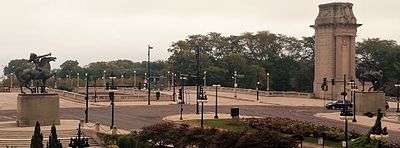The Bowman and The Spearman

.jpg)
The Bowman and The Spearman, also known as Indians,[1] are two bronze equestrian sculptures standing as gatekeepers in Congress Plaza, at the intersection of Congress Parkway and Michigan Avenue in Grant Park, Chicago, United States. The sculptures were made in Zagreb by Croatian sculptor Ivan Meštrović and installed at the entrance of the parkway in 1928. Funding was provided by the Benjamin Ferguson Fund.[2]
Structure
Each statue stands seventeen feet high and rests atop an eighteen-foot granite pedestal.[3] When the area was first designed, the statues were intended to guard a grand staircase into the park. However, this staircase was removed when Congress Parkway was extended in the 1940s.[4] Research in 2006 suggested that the lettering on the pedestals designed by architects Holabird & Roche was executed by sculptor Rene Paul Chambellan.[5]
History
The idea of placing large sculptures at the park entrance originated from famed urban planner Daniel Burnham's 1909 Plan of Chicago. Burnham, a man of vision and charisma, was a strong influence on how the lakefront appears today.[6] He imagined a vast parkland stretching from Michigan Avenue to the lakeshore filled with beautiful gardens, walkways, and public works of art. Burnham himself, however, planned for the two statues to be of “one Indian and one ‘Buffalo Bill like’ depiction of the conquering white pioneers”[3] to symbolize both America’s Indian heritage and its struggle for expansion.[7]
An unusual aspect of the sculptures is that both figures are missing their respective weapons, the bow and arrow and the spear. The omitting of the weapons was intentional, as the artist preferred that they be “left to the imagination while attention is focused upon the bold lines of the musculature of both man and beast, as well as the linear patterns of the horses’ manes and tails and the figures’ headdresses.”[4] Despite the fact that the weapons never actually existed, many theories have existed over time as to their supposed whereabouts. Some believe that they were taken as part of an elaborate prank, while others are under the impression that their removal was a show of respect after the events of September 11, 2001.[8]
One author said of these works, "Meštrović's finest monumental sculptures are his Chicago Indians (1926–27), they are not too obviously stylized: the muscles on the horsemen are almost anatomically realistic... These statues show how much more important true sculptural feeling is than ideology, for Meštrović hardly knew anything about the ideals of the American Indians and they certainly did not move him."[9]
After completing a number of statues in Europe and other parts of the world, Meštrović returned to the United States and spent the remainder of his life as a celebrated professor first at Syracuse University and later at the University of Notre Dame.
Latitude and longitude coordinates
- The Bowman: 41°52′34″N 87°37′25″W / 41.87598°N 87.62348°W
- The Spearman: 41°52′32″N 87°37′25″W / 41.87550°N 87.62348°W
Further reading
- Kečkemet, Duško, Ivan Meštrović, Publishing House, Beograd, Jugoslavija 1964
- Kečkemet, Duško, Ivan Meštrović – Split, Meštrović Gallery Split and Spektar Zagreb, Yugoslavia 1969
- Kečkemet, Duško, Ivan Meštrović, McGraw-Hill Book Company, NY, NY 1970
- Kvaran, Einar Einarsson Architectural Sculpture in America, unpublished manuscript
- Schmeckebier, Laurence, Ivan Meštrović – Sculptor and Patriot, Syracuse University Press, Syracuse, NY 1959
References
- ↑ Sokol, David M. (2005). "Art, Public". The Electronic Encyclopedia of Chicago. Chicago Historical Society. Retrieved 2009-03-20.
- ↑ Hermann, Andrew (1991-08-09). "Public statues are lumberman's legacy to city". Chicago Sun-Times. Retrieved 2009-03-18.
- 1 2 Karamanski, Theodore (Spring 2004). "Monuments to a Lost Nation". American Indian Online Project. Retrieved 26 September 2015.
- 1 2 Koenig, Wendy; Badowski, Christine (22 August 2013). "The Bowman and the Spearman". Chicago Public Art. Retrieved 26 September 2015.
- ↑ Kvaran, Einar Einarsson Architectural Sculpture in America, unpublished manuscript
- ↑ Wille, Lois (1991). Forever open, clear, and free : the struggle for Chicago's lakefront (2nd ed., University of Chicago Press ed.). Chicago: University of Chicago Press. pp. 82–98. ISBN 0226898725.
- ↑ "The Bowman and The Spearman". Public Art Archive. Retrieved 26 September 2015.
- ↑ Merevick, Tony (22 March 2011). "Warrior statues missing weapons". Timeout Chicago. Retrieved 26 September 2015.
- ↑ Keckemet, Dusko. ‘’Ivan Mestrovic’’, McGraw-Hill Book Company, New York, 1976 unpaginated